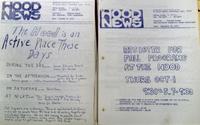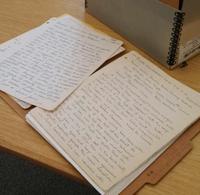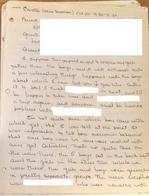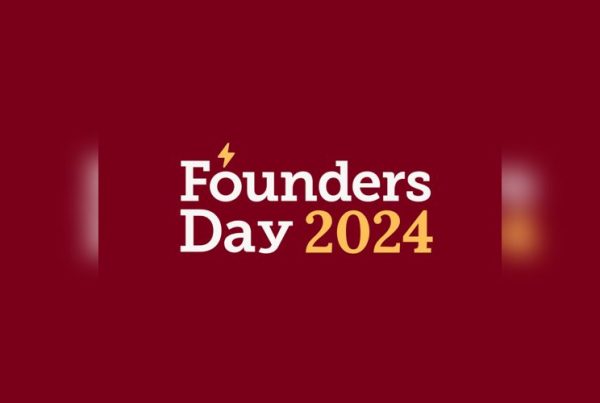Elizabeth Vocasek (M.Ed. in Youth Development Leadership, 2013) contributed this blog entry about using sources in the Social Welfare History Archives and Kautz Family YMCA Archives for a class project for the Organizational Approaches to Youth Development course in the School of Social Work at the University of Minnesota. Her entry reflects on the challenges and inspirations of her time at the archives. She also reveals how her experiences using the archival collections influenced her when preparing her M.Ed. degree portfolio. Inspired by her archival research to reflect on the “artifacts” of her time at the University, she framed her portfolio as an historical narrative and retraced her steps through the degree program by looking at various artifacts that were produced over the course of her studies at the University. Her essay is a wonderful example of how the impact of using archival sources spreads beyond the classroom setting.
Linnea M. Anderson, Interim Archivist, Social Welfare History Archives
By Elizabeth Vocasek, .Ed. in Youth Development Leadership 2013
 As I entered the Andersen Library Reading Room a little over a year ago with nothing but my pencil, notebook, and the instructions to look for something related to youthwork within the Social Welfare History Archives, I felt more than a little bit daunted. I stared at the boxes full of reports, photos, memos, pamphlets, flyers, and books, and I thought back to the advice I had received: Let the materials speak to you. So, I started digging, sorting, scouring, trying to make sense of it all. Yet, after what felt like hours, days, years of rummaging through folders and boxes looking for an ambiguous something, the only “speaking” I heard was not from the materials, rather from my project partner as we exasperatedly whispered across the table clueless as to what we were supposed to be finding.
As I entered the Andersen Library Reading Room a little over a year ago with nothing but my pencil, notebook, and the instructions to look for something related to youthwork within the Social Welfare History Archives, I felt more than a little bit daunted. I stared at the boxes full of reports, photos, memos, pamphlets, flyers, and books, and I thought back to the advice I had received: Let the materials speak to you. So, I started digging, sorting, scouring, trying to make sense of it all. Yet, after what felt like hours, days, years of rummaging through folders and boxes looking for an ambiguous something, the only “speaking” I heard was not from the materials, rather from my project partner as we exasperatedly whispered across the table clueless as to what we were supposed to be finding.
Yet, as all things eventually do, the project slowly but surely began to take form. The bits, pieces, memos and reports that had originally seemed stale and pointless began to weave together into a vibrant story that neither my project partner nor I could validate nor discredit. Though at first we felt confident that we had truly found something real and concrete, we eventually began to question that which we were finding. Moreover, we began to question that which we weren’t finding.
It soon became clear to us just how much our thoughts, feelings, perspectives, and premonitions could shape the story we were “reading” from the archive materials. Was the story we had devised actually fact? Was it fiction? Were the images in our minds, the history we were to present an accurate glimpse or even a slightly muddled snapshot of life in years past? We had a few concrete answers, but more than that we had questions.
 Eventually, the project came to an end. We finished it feeling both enlightened, confused, and curious not only about the process but the outcome as well. Just how much had our perception and our own histories influenced what we called “truth?” I didn’t know, my partner didn’t know, and we didn’t know if we ever would. The narrative we concocted was not right or wrong, it just was―or it seemed to be anyway.
Eventually, the project came to an end. We finished it feeling both enlightened, confused, and curious not only about the process but the outcome as well. Just how much had our perception and our own histories influenced what we called “truth?” I didn’t know, my partner didn’t know, and we didn’t know if we ever would. The narrative we concocted was not right or wrong, it just was―or it seemed to be anyway.
Days went by and the year continued on. From time-to-time, I would think about the project. I would reflect on what I had gleaned from the content as well as the experience exploring history in an entirely new way. A story had been written, a construct developed, and yet I still wondered if reality was anything like the vision that was dancing in my brain.
I finished my coursework, moved out of the Twin Cities, and months later faced the challenge of creating a final portfolio for my degree. As I sat in my brother’s house surrounded by boxes of belongings which I had brought with me, I began to think back to my experience in the Social Welfare Archives. These boxes―they weren’t just boxes; they were more that. They didn’t contain notes, papers, cards and trinkets that I had haphazardly tossed into boxes during my departure. No, these were artifacts―the artifacts of my life.
As I looked back over the objects, bit-by-bit, piece-by-piece as I had done back in Andersen, I started to see my life in a different way. I thought about my final portfolio, about everything I had learned over the past fifteen months, and it was evident that my education was not just that which had occurred under the guise of the University. I had a story to tell, something to share, and I needed to do it using both narrative and artifacts alike.
 So, I sat down at my computer and scribbled the tale not only of my time in Minneapolis but the years before and the experiences which had led me to that place. I pieced my life together, venturing along the timeline of my past, and added mementos and words that attached me to a life beyond the classroom walls. When all was said and done, I narrated my history while the artifacts told theirs.
So, I sat down at my computer and scribbled the tale not only of my time in Minneapolis but the years before and the experiences which had led me to that place. I pieced my life together, venturing along the timeline of my past, and added mementos and words that attached me to a life beyond the classroom walls. When all was said and done, I narrated my history while the artifacts told theirs.
I finished sooner than expected, and I sat there wondering if I had done justice to the project, to me, to my fifteen months, to the people who would uncover these silly bits, pieces, and ramblings in years to come. I did not know if what I shared was authentic or just merely a flawed perception of a series of events linked together by one common thread: me. I told the truth from my perspective, but I knew within the contents of those boxes and the portfolio I prepared a different truth may very well exist.
As I reflect now, my projects all completed and my diploma packed away―it is evident how relevant to me that experience grasping history in the Andersen Library Reading Room was and is. I can’t help but wonder what else was in those boxes that went undiscovered―what artifacts were missing, where they went, and why. I think about my own life, the sort of picture my collection of artifacts will paint about me. I don’t know what it will say or how, and I don’t think we are meant to know. What I do feel is a gratefulness for experiences such as these, those which make us stop and question ourselves, our truth, our lives, and that which we think we know. The fact of the matter is―rather something I believe―despite the attempts we make to define, record, and present ourselves in a certain manner, a story is being written that goes far beyond our touch and influence. At the end of it all, that glimpse of an uncertain reality may be the only piece of history that the world ever knows.




